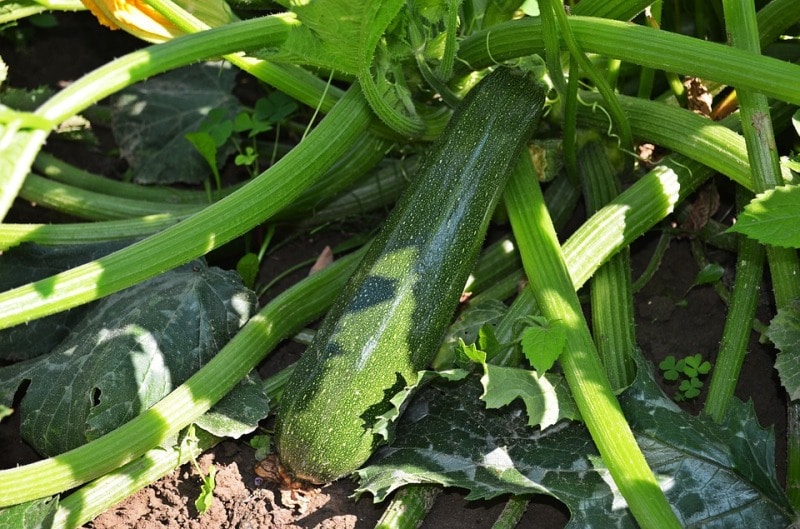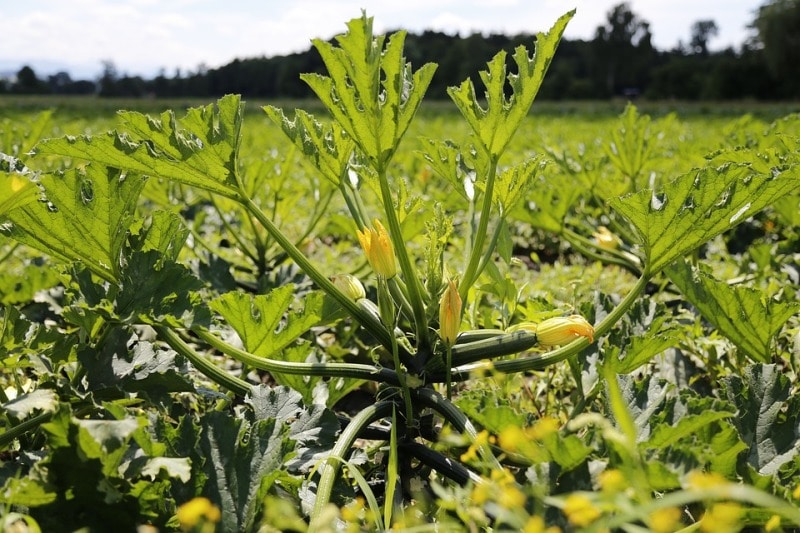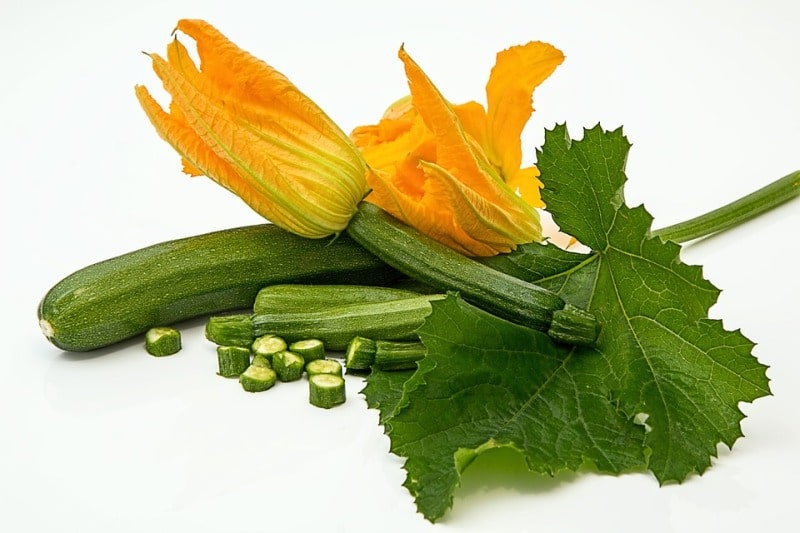A step by step guide Zucchini planting process:
Today, let us give you some information about Zucchini planting from seed, Zucchini plant care, and Harvesting procedure. Zucchini which is also called as courgette is a summer squash belonging to the family of Cucurbitaceae along with spaghetti squash, melons, and cucumbers. It will be growing to a height of 3 feet but is generally harvested when it is still immature measuring up to 7 to 8 inches.
Though Zucchini is mostly considered as a vegetable, it is categorized as a fruit in terms of Botany. Fruits occur in most of the Zucchini varieties and will be available in different colors starting from dark yellow to green. While the origin of squash is in America, Zucchini is a variety which is originated from Italy. Zucchini is used as a medicine for the treatment of aches, cold and several health conditions. Anyways, not all the uses of Zucchini are supported by Science.
Growing zucchini is very easy and is the best vegetable which will help you to encourage your children to grow in a garden. Once you start the Zucchini seeds, it will take less time for harvesting which will make the young gardeners get interested in it.

Preparing for the plantation of Zucchini:
- You will have to make a decision about how you are starting your Zucchini. Normally, there are two methods of propagation of Zucchini. One is by the plantation of seeds and the other is by buying a small zucchini plant which is existing already and then transplant it into the garden. If you have chosen to grow the zucchini from seeds, you can start them before1 to 1 ½ month of the time of planting them in the outdoor locations based on the climatic conditions of your locality. Taking a pre-potted plant will always be simple and consumes less time, but this would not be as satisfying as growing your zucchini from seeds.
- There are some varieties of zucchini, but the squash is usually the same. You can find zucchini classified as “dense habit” or “open habit” which will refer to the way the leaves are growing on the bush.
- Most of the zucchini which are of bush varieties are termed as summer squash whereas vine varieties are termed as winter squash.
- Zucchini will change in a natural manner between a yellow hue and a dark green, almost closer to black. Few have mild spots or stripes which are casual and this should not trouble you.
- Zucchini is generally termed as summer squash, as it survives and produces at its best at the time of summer. Few varieties are termed as winter squashes, but this has to be done at fruiting time instead of plantation time. Zucchini is a vegetable which loves to grow in the sun and will not do well if the soil is cold. Hence, start the plantation of zucchini when the soil temperature in the outdoor locations is at a minimum of 15°C. This has to be done generally after the first week or a second week of the spring season after all the possibility of frost is passed.
- If you are unable to decide when to start the plantation, you can get in touch with your local agricultural office to get the complete information on the plantation times for zucchini present in your location.
- Get a perfect time for plantation. Zucchini will be able to survive in a location which receives full sunlight with a lot of space to spread. Choose a place in your garden which will be able to supply zucchini with a minimum of 6 to 8 hours of sunlight in a day and which does not have much amount of shade. Make sure that you are choosing a place which has soil which is well-drained. Zucchini is a vegetable which likes when the soil is moist but not in the soil which is soggy.
- If required, you can also go for the improvement of drainage by the plantation of zucchini on soil mounds or through a large number of changes like amendment of soil and drainage systems.
- You can go with the plantation of zucchini in a locality which has exposure to the south to get a maximum amount of sun.
You may also read the Growing Beans Hydroponically.
Preparation of soil for Zucchini planting:

- Though most of you will not have enough time to do this, preparation of soil a few months before the plantation will lead to the best growing conditions for zucchini.
- You can start this by adding fertilizer or a gardening mulch for supplying the soil with the essential nutrients.
- The pH of the soil has to be tested and you can amend it if required. Zucchini prefers a soil which has a pH between 6 and 7.
- For making the soil more acidic and lower the pH of the soil, add in some amount of peat moss or pine needles. For making the soil alkaline and raise the pH, add in some amount of lime.
- For adding the organic material and nutrients, the compost has to be tilled into the soil 4 weeks prior to the plantation. After this, make sure that you are covering with mulch until the time of plantation.
- If you see that your soil is not draining well, add in some amount of sand which helps in encouraging the drainage.
Starting the Zucchini seeds:
- If you do not want to take the risk of starting the seeds directly in the soil, you can start them in the indoor locations 1 to 1 ½ month before you transplant them to the outdoor locations.
- Take the seed trays, a potting mixture which does not contain soil and the seeds.
- Keep one seed in each tray and then cover it with a ⅛ inch of potting mixture and then make sure that you are watering it well.
- These trays have to be placed in a location which will receive sunlight and is the temperature of a minimum of 16°C. When the second bunch of leaves sprout, the zucchini seedlings will be prepared for transplantation to the outdoor locations.
You should not miss the Growing Garden Sorrel.
Zucchini planting procedure:
- Make use of a gardening trowel for digging a small hole for your plant. If you are going with the plantation of seeds, you will have to stick every seed less than a half-inch below the soil. For the seedlings of zucchini, each hole has to be dug to be somewhat larger than the root ball for the plant. Maintain a space of 100 cms between the plants. If required, you can also consider thinning of the seedlings.
- Each zucchini seed has to be placed it you can also start by putting it in its hole which you have dug. The seeds have to be covered with a ½ inch of soil so that they would be able to receive the required water and sunlight to undergo the process of germination.
- The zucchini transplant has to be covered by making use of the sufficient soil for covering the root ball without going up to the stem. The plantation has to be finished with a huge watering and then your part is done.

Zucchini planting care:
- You will have to keep monitoring the zucchini when they are in their growing stage.
- These are the plants which require relatively low maintenance, but they do need some amount of care when they are in a stage of production.
- You will have to remove any weeds present in the location of plantation and also make sure that you are applying a mulch layer if weeds seem to be a problem.
- Adding a liquid growth fertilizer once a month will help in the promotion of growth of your zucchini.
- Remove any of the fruits or branches which are about to die or suffering from any disease for the prevention of spreading to other sections of the zucchini plant and also for the promotion of its growth in a continuous manner.
- For encouraging your plant to start the production of zucchini fruit, it should become pollinated. If you do not have bees or any other insects which pollinate in your locality, or if your plants seem to not produce any squash, you can start the pollination of your plant by yourself.
- For this, you will have to choose a male zucchini flower, which can be identified by its stem which would be tall. This stem would be slender and will consist of a stamen which is visible at its center.
- Pull the flowers on the stems in a careful manner and start rubbing the stamen inside a female zucchini flower. The female zucchini flowers will have stems which are short and they will have a bulbous growth where the flowers join the stem and do not have stamens.
- You can continue doing this will many flowers or stop it with a few based on the time you have with you and the growth which you are trying to improve.
In case you miss Growing Hydroponic Amaranth.
Harvesting Zucchini:

- When Zucchini reached the size of 4 inches, then it means that they are prepared to be picked. Picking up the zucchini on a regular basis will help in the promotion of production of squash.
- So, if you want plenty of squash, then you will have to pick all of the zucchinis as they reach the stage of maturity.
- If you do not require too many squashes, you can leave at least one zucchinis on the vine for the complete zucchini growing season for slowing down the production.
- For harvesting your zucchini, you can make use of a sharp knife to divide the squash from the stem which is rough and which attaches it to the bush.
- You can consume the flowers by adding them to salads. These can be consumed and if you are picking them off, you will not see the growth of zucchini fruits often.
- Zucchinis continue their growth until the first frost if their establishment is done well at the time of spring.
- You can also cut the stem of zucchini in a simple manner for the promotion of its growth if you are not interested to harvest the complete squash at a time.
That’s all gardeners about the procedure of Zucchini planting from seed. Keep growing veggies.
You may also like the Horticulture Farming; Types of Horticulture.